EBR charges a service fee to manufacturers to produce ebike reviews and videos, this began in 2018. It’s the same flat fee for each bike, and it helps us to keep the site going while limiting ad clutter. We appreciate the opportunity to serve you with our opinions and data but respect your right to know that we receive compensation :)
The Phantom Kit is one of EBO’s sleekest, coolest looking, and lightest weight product offerings. The bullet style battery looks a lot like a water bottle or thermos, and doesn’t take up as much room. On the converted Pure City Classic frame shown in the video review and images above, there was enough room for the battery and a folding lock to be mounted on the downtube and seat tube respectively! Since Electric Bike Outfitters sells black or silver hub motors and rims, you can really get their kits to match your bike, and the all-black look of the Pure City Classic definitely makes an impression. Cables for e-bike kits are usually black, and they tend to look cluttered when compared to purpose-built electric bikes which usually have internally routed cables. By going all-black, the clutter starts to disappear… and, EBO sells custom wire lengths, so you will be able to convert longer bikes or get shorter lengths for a tidier setup. The big takeaway with this and other kits is that you end up with more flexibility and options, but have to do more work and will probably make some compromises on aesthetics. There are similar looking kits out there which are sold for less, but Electric Bike Outfitters has been in business since 2015 and provides a 30-day return policy and one-year comprehensive warranty. They hand-spoke their motors into a broad range of rim sizes and offer several hub spacing widths. You can buy this kit for a front or rear wheel, opt for a single-speed drivetrain or 7 to 9 speed cassette, you can get a fancy LCD display with integrated USB port to charge your phone on the go, or a simpler LED console. The biggest consideration, that I found when talking to the founder of EBO, is that the pins in the battery mount can get stuck after a year or two of use and then damage the batter base (arcing and melting the plastic). He explained that you can deter this issue by using some Lithium grease spray and a tooth brush to clean the pins occasionally. Jason is a pretty straightforward guy, and he told me that he has considered dropping this battery style on many occasions… and that he includes a warning and instructions to help people avoid issues, but that the aesthetic appeal of the Phantom Kit keeps it as a top seller, so he continues to do his best supporting it.
Driving this kit is a 350 watt nominal, 612 watt peak, planetary geared hub motor. This type of drive unit tends to be the lightest, most compact, quietest, and most hidden that you can find, but it offers lower torque of ~21 Nm. If you choose a front-mounted motor (a great option for trikes), it won’t impact your steering as much as the bigger drive units. Rear-mounting is more complicated, but provides the best traction and usually more mounting strength. Either approach is fine, and Jason has gone to extreme lengths engineering his motor casing to step-in and fit the widest range of forks… because some forks bulge in and can scrape cheaper kits. I have experienced this first hand when converting a Hill Topper Kit years ago. For the video review, Jason opened up one of his motors and allowed me to film the internals and show the plastic gears. You can see this above, and get a better idea of what’s going on inside. There’s a small fast motor in the middle that gets converted into a slower but more powerful output via reduction gearing. It actually feels very satisfying and zippy, but is meant for more active riding on relatively flat terrain, you can definitely climb hills with it, but will want to pedal along and help so it doesn’t strain. Jason did tell me that his motors have overheat protection, so even if you do try to climb hard, it shouldn’t damage the motor. And so, once you have chosen a rim size, decided on a front or rear wheel setup, received the kit and fitted the axle into your dropouts, the tightened the nuts to secure it in place, you will have this power cable protruding from the right side of the axle. This is what sends electricity from the 17 amp controller (which is located in the base of the battery) to your motor, to make it go. It’s one of the more vulnerable parts of this, and most, hub motor kits. Be careful not to snag this cable or let the bike tip over and bend it, or it could break. This kit does not come with an external torque arm by default, but if you’re concerned about the integrity of your bike frame, it is an option that Jason offers, and I want to point out that he uses thicker 12 gauge spokes when his team hand-spokes each kit into the selected wheel.
The battery pack that comes with this kit is the star of the show, and it really does look nice. I learned, while visiting the EBO headquarters in Denver Colorado, that the Burly, Cruiser, and Phantom kits all use the same motor, so you’re rally just choosing the battery design, capacity and mounting setup. With the Phantom, you get a really compact design that allows for more accessories to fit… or perhaps for a rear suspension setup. I saw it installed on an upright EVO trike, a recumbent bike, and a traditional diamond frame, each using a different mounting spot and approach. Since the pack only weighs ~5.42 lbs, you could possibly even mount two of them! I saw a setup like this with one of Jason’s Burly kits on a sporty recumbent that one gentleman was preparing to use for touring. You can charge the Phantom battery on or off the frame, it uses the same circular plug design and the charger offers a very standard 2 amps of power flow but only weighs ~1.1 lbs. It’s easy to bring the charger along to extend your rides, or order an additional charger from EBO to stash at work. This kit would be great for commuting, and I noticed that the battery casing has a plastic lip at the top, which serves as a handle for secure lifting and carrying. There’s a grey button near the top that activates an LED charge level indicator, and a toggle switch on the lower right side. You can completely de-activate this battery for safety, and to reduce battery discharge when not in use. To really extend the life of this, and other Lithium-ion packs, it’s best to keep them above 20% to avoid chemistry stress and avoid storing in extreme heat or cold. Also, check on the pack and top it off after every few months if you haven’t used it.
Moving on to operation, once the battery is charged up, mounted, and switched on, you can hold the power button on the control pad, which is usually mounted near the left grip. At this point, the LCD screen (or LED console) comes to life. The default display hardware that comes with the Phantom is a beautiful backlit KT branded LCD with integrated USB charging port. However, EBO does offer to swap this display for a more basic LED console, to reduce handlebar clutter and limit the fancy look of the kit (which could attract unwanted attention in some situations or take up space where you might have a phone or drink holder). The other interesting use case for the LED console is if you have long cruiser bars, because the standard display + control pad doesn’t have a long enough wire to reach the grip. The LED console can reach this distance and would be easier to control without taking your hands off of the grips. Since the LED console is so simple, I’m going to focus mostly on the LCD screen from here on out. Neither one of these two display panels is removable, but both can be swiveled a bit to improve readability or reduce glare if you don’t over-tighten them. The LCD shows all sorts of menus, but only uses three rubberized buttons to operate. This control system combines simplicity with depth, and is intuitive to use, without requiring that you look down all the time to change assist levels, once you get the hang of it. The power button in the center of the control pad allows you to cycle through trip stats like odometer, trip distance, average speed, max speed etc. and the up and down arrows allow you to raise or lower the assist setting. By default, the bike is set to assist level zero, so that the throttle is inactive. Once you arrow up to 1-5, the pedal assist sensor goes live and you can instantly use the throttle with full power. It ramps up smoothly and feels a bit more refined than some other systems I have tried. I prefer to pedal with an efficient, lower level of pedal assist, with occasional bursts of power to start from rest, catch up with friends, or climb hills, and all of the EBO hub motor kits let me do this. Whether you’re riding in bright light or complete darkness, the LCD display should be viewable, because you can hold the up arrow to activate backlighting. Holding down will activate walk mode if the bike is stopped. If you enable cruise control in the settings menu (by holding up and down simultaneously to get to the setting) you can then hold the down arrow while riding at speeds above 6 mph to activate cruise control and give your legs, wrist, or thumb a break! If you set cruise while pedaling however, you have a second or so to discontinue pedaling or it will shut cruise off again. Cruise control is a feature I don’t see a lot, and one that some people might really appreciate for long commutes our touring. The other thing that will override cruise control is pulling either of the two brake levers, because they have motor inhibitors built-in. There are so many settings to explore here, including lower top speeds, a security password to keep the bike from being tampered with or ridden by young people, and the ability to change the cadence sensor sensitivity. Jason convinced me that eight magnets was enough for their cadence disc (verses 12 magnets that I have seen on some other ebikes and kits). He explained that the disc itself is smaller and less likely to be bumped this way, but that it is still very responsive. Apparently, some people want to set their cadence sensors to be less sensitive, so that the bike won’t surprise them if an accidental partial pedal stroke is made, and you can indeed make the cadence sensor less responsive this way by exploring the settings menu and using Jason’s manual as a guide. The cadence sensor itself is one of the more difficult parts to install with this kit, because it requires a bottom bracket wrench and crank puller or help from a shop to get on. It’s not an easy clip-on design, but the benefit is that it should be more sturdy and reliable in the long run. In one example, with the EVO Trike, they had opted for throttle only, completely skipping the cadence sensor installation and simplifying drive modes for an elderly customer. In short, I appreciate how useful and open the control systems are on this ebike kit, how much choice they give you. When conducting this review, Jason had explained that the display had a 20 second lag for the current speed to register (based on their new firmware that works with 36 and 48 volt motors. I was thankful that Jason was aware of the issue and honest about it as we talked on camera, he has since resolved this issue (late February 2018) but I wanted to keep this note for those who might have an older version.
All things considered, I feel that EBO is a trustworthy company and that the Phantom kit looks cool, but is probably less reliable than the Burly 36 Volt Kit, which uses a different battery design and actually gives you more capacity for the same price! They weigh very similar (maybe 0.5 lbs heavier for the Burly), it’s just a taller battery casing design. Jason was hesitant for me to even review the Phantom, because of the pin issues he has seen, but I wanted to dig in and really explore why this kit still makes sense in some cases and how to care for it properly… My understanding is that it can work reliably if kept clean and if you use the corrosion cleaning Lithium grease occasionally if you notice the pins getting tight. Maybe you could avoid the arcing issue by never taking the battery off of the mount? It’s not really possible for me to say, as I have not owned one or used for extended periods. I also thought it would be good to dig into this kit and share all of this feedback because there are non-EBO kits that use the same battery design, and they probably also suffer from the pin locking issue. In short, I love how versatile the wheel sizes, dropouts, colors, wire lengths, and displays all are. I love that you can purposefully lower the top speed of the kit (worth considering for upright trikes and less agile riders). It’s neat that you can fit this battery into tighter spaces, and that it blends in so well on black bikes. Electric Bike Outfitters is now using Julet connectors, so all of the wires are color coded and easier to install or fix. You get mechanical motor-inhibiting brake levers by default but there’s a workaround if your bike has hydraulic brakes, and one of the demo bikes had all of the controls setup on the left grip of a recumbent for a stroke survivor who had limited mobility with his right arm. Big thanks to Jason and his team for hosting me and partnering with me on this review. It was nice to catch up with him and see how the product has been refined since 2015. He is expanding in a way that seems sustainable, definitely growing across the US and even internationally, and I love that his support is still above average for the industry (at least the kit industry). It’s part of the slightly higher pricing, and also what makes dealer sales possible. I was impressed to hear that several Denver ebike shops actually carry his kits and offer them as an alternative over purpose built products. There’s something to be said for recycling an existing bike, breathing new life into an old favorite, or building a truly custom setup that isn’t available anywhere else. I welcome your comments and feedback below, or you can connect directly with other owners and enthusiasts in the EBO Forum.
Pros:
- EBO has been in business since 2015, they offer a generous 30-day return policy with a one year warranty, and they ship worldwide… I trust them a lot more than some of the generic kits found on Ebay
- The Phantom kit looks really cool and offers a lot of choice in terms of motor casing and rim colors, you can get silver or black to match your frame
- Whether you’ve got a recumbent, kids bike, folding bike, city bike, or mountain bike, it seems like Electric Bike Outfitters can build a wheel to fit your bike because they spoke in-house and build to order
- EBO uses thicker spokes when they build motors into rims to handle the additional forces, their new Julet connectors are water tight and color-coded for easier assembly and repair, they offer custom wire lengths to fit many types of bikes
- Safety is a big focus for me, so I appreciate the more precise cadence sensor, adjustable top speed settings, different throttle options (trigger, half-twist, and full-twist) as well as the brake lever motor inhibitors
- If your bike uses hydraulic brakes, EBO does have an optional sensor and magnet unit that can be screwed and glued-on to enable motor inhibiting, it’s not as elegant or simple as the stock mechanical brake levers but at least it’s an option
- The display panel is large, easy to read, full of interesting settings to experiment with (and EBO has a nice manual to help you do so on their website), and it has an integrated USB charging port, though the display cannot be easily removed for protection at bike racks
- The hub motor itself is fairly quiet, even when being used at the higher assist levels and higher top speeds, this is due in part to the lower 36 volt operation of this kit
- Even if EBO eventually goes out of business or changes some of their kit hardware, you should still be able to get most of the parts for this kit and have your battery case re-packed because they are not software locked and follow an open industry-standard
- This is the lightest battery pack option that EBO sells at just ~5.42 lbs, it’s great that there’s a lip built into the plastic top piece so you can carry it more securely, I suggest storing it in a cool dry location and avoiding extreme heat and cold to help the cells stay healthy
- The battery charger is a bit basic, only offering a standard 2 Amp power output, but it’s very lightweight at just ~1.1 lbs, it’s also compact and should fit into your backpack or other bags easily for charging on the go
- On the one hand, installing the hard-mounted cadence sensor for this bike takes more time and tools than one that is glued or zip-tied on, but on the other hand, it is going to be more secure this way, and I found that it worked very well during the ride tests
- The hub motor can be setup in a front or rear wheel configuration, and EBO offers single speed or 6 to 9 speed cassettes from Shimano and Sun Race
- Being able to transform an existing bike into electric with multiple drive modes like this for just over $1.1k seems pretty good to me, there are cheaper kits out there, but most of them don’t offer this level of performance, customization, or support
- For those who want a really compact display to save room on their handlebar or just less flashy hardware on their bike, EBO offers a black LED control pad with integrated buttons… and I like this thing because it has a basic speedometer built in! most other LED control pads only show your battery charge level and assist, this control pad might be a good choice for use with longer handlebars since the wire length of the remote button pad is limited (as shown with the EVO Trike in the video review above)
- You can activate walk mode to help move your bike by holding the down arrow if it is standing still, if you enter into the menu settings you can activate cruise control and then when riding over 6 mph, hold the down arrow for a few seconds to set cruise speed, in the settings you can also enable throttle mode at assist level zero if you want… or even remove the throttle and only use pedal assist, there are just so many options here
- Before shipping each battery, the team at Electric Bike Outfitters actually drains and refills it to test all of the cells, I was told that they experience a ~1% failure rate from their suppliers and by testing like this, it saves end customers time and hassle
- The actual motor casing for the Phantom and Burly kits has been custom designed by Jason, the founder of EBO, and he made it fit on a greater number of narrow forks by stepping it in, it works with linear pull brakes or disc brakes (you can mount dis brake rotors directly to the side of the hub casing as shown with the EVO Trike here)
- Hub motor ebikes can often have more pedal gears to work with than mid-motors (because they can easily support multiple front chainrings), and shifting gears causes less wear on the drivetrain because the motor power is separate from the chain, cassette, derailleur etc.
- The bullet or bottle style battery on the Phantom Kit allows for more space on the seat tube or top tube, which could enable you to use a second set of bosses (as seen with the folding lock on the black Pure City Classic bike in the video), or could allow room for a rear suspension
Cons:
- Unlike a purpose-built electric bike, kits usually have extra wires that aren’t as hidden or neat looking, the battery mount slide connects to the downtube with two bolts vs. three or some even sturdier custom design, but it looks sleeker than some of the larger Dolphin and Shark packs on other kits
- I was told by Jason that the spring loaded pins on the battery mount can sometimes get locked into place after a year or two if the bike is exposed to water and dust, this can cause damage to the base of the battery where the pins align and send power, he recommends keeping it clean and checking on it regularly
- The 8-magnet cadence sensor for this kit worked pretty well, and can be adjusted for sensitivity in the settings area of the display, but it simply isn’t as fluid or dynamic as a torque sensor or multi-sensor, there’s a bit of lag starting and stopping, but it’s great that the kit comes with motor inhibitors on both brake levers
- Installing a kit like this will take a bit of time, energy, and possibly additional tools like a crankset puller and bottom bracket wrench, you might even want to pay your local ebike shop to help you… and that adds to the price
- For some of the older versions of this kit, the display panel might have a 20-second lag before showing your current ride speed, I was told that this has since been resolved with a software update, apparently the speed sensor is integrated into the motor hardware, the delayed readout was a minor annoyance and could cause confusion at times
- Most hub motors (including this one) have the power cable entering into the axle from one side, and this can be a point of vulnerability if the bike tips or you ride close to obstacles that could snag or scrape it, a few of the new Dapu motors have their power cables tucked very closely (behind the disc brake rotor) but I don’t think that you can order them as kits, just be careful with the power cable here
- Turning this bike on and off requires two steps, which adds a bit of time, you first have to click the toggle switch on the battery pack itself on and then hold the power button on the control pad, just remember to turn it all off before dismounting, transporting, and storing the bike to prevent accidental activation and slow battery draw
- Minor gripe here, the signal cable going from the button pad back to the display panel is not long enough to reach all the way out on some large cruiser bars, this means that it may not be within reach (as demonstrated in the video review for the EVO Trike above)
Resources:
- Official Site: http://www.electricbikeoutfitters.com/ebo-phantom.aspx
- More Pictures: https://photos.app.goo.gl/ct9338xa42FKYCqF3

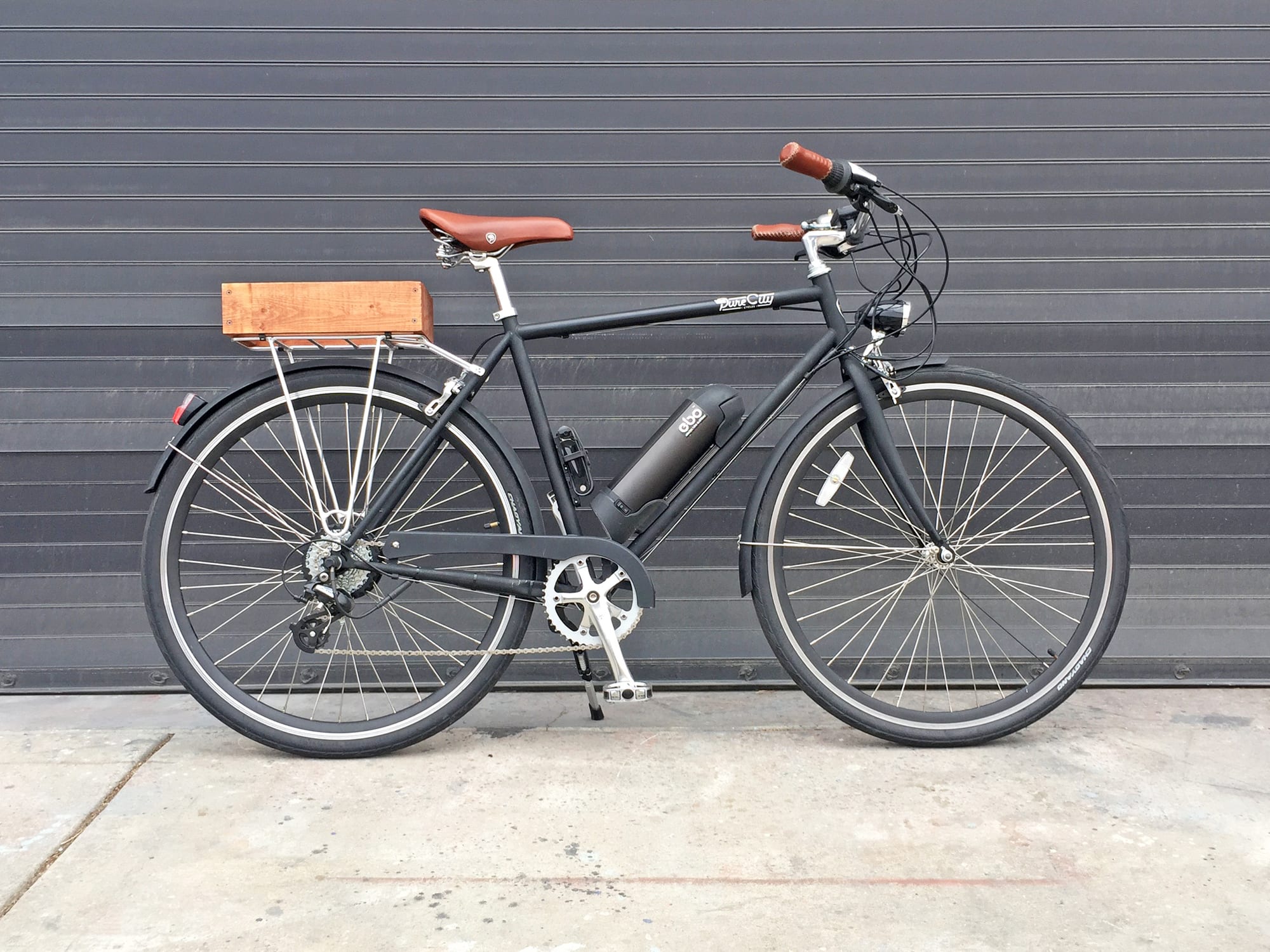
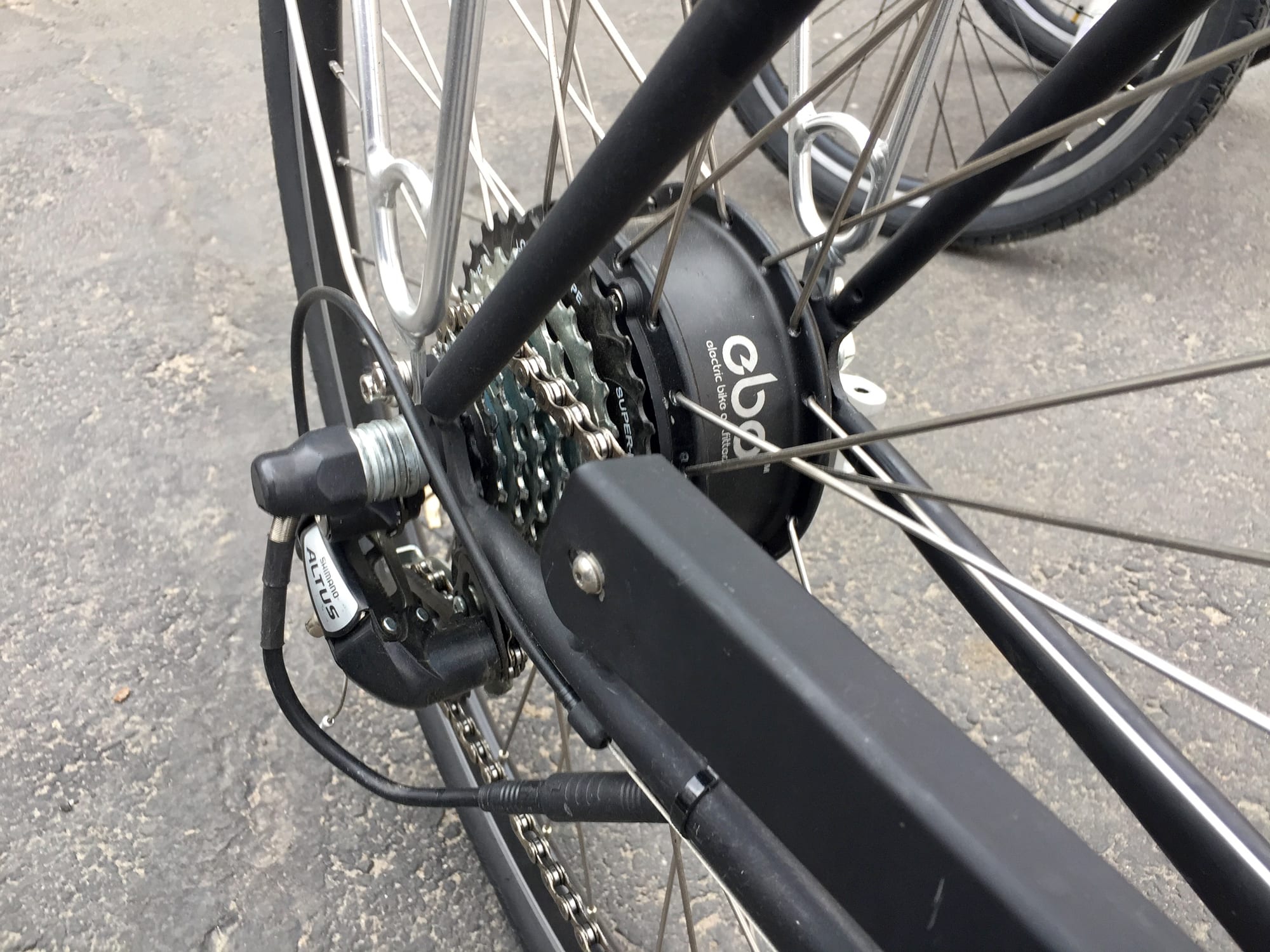
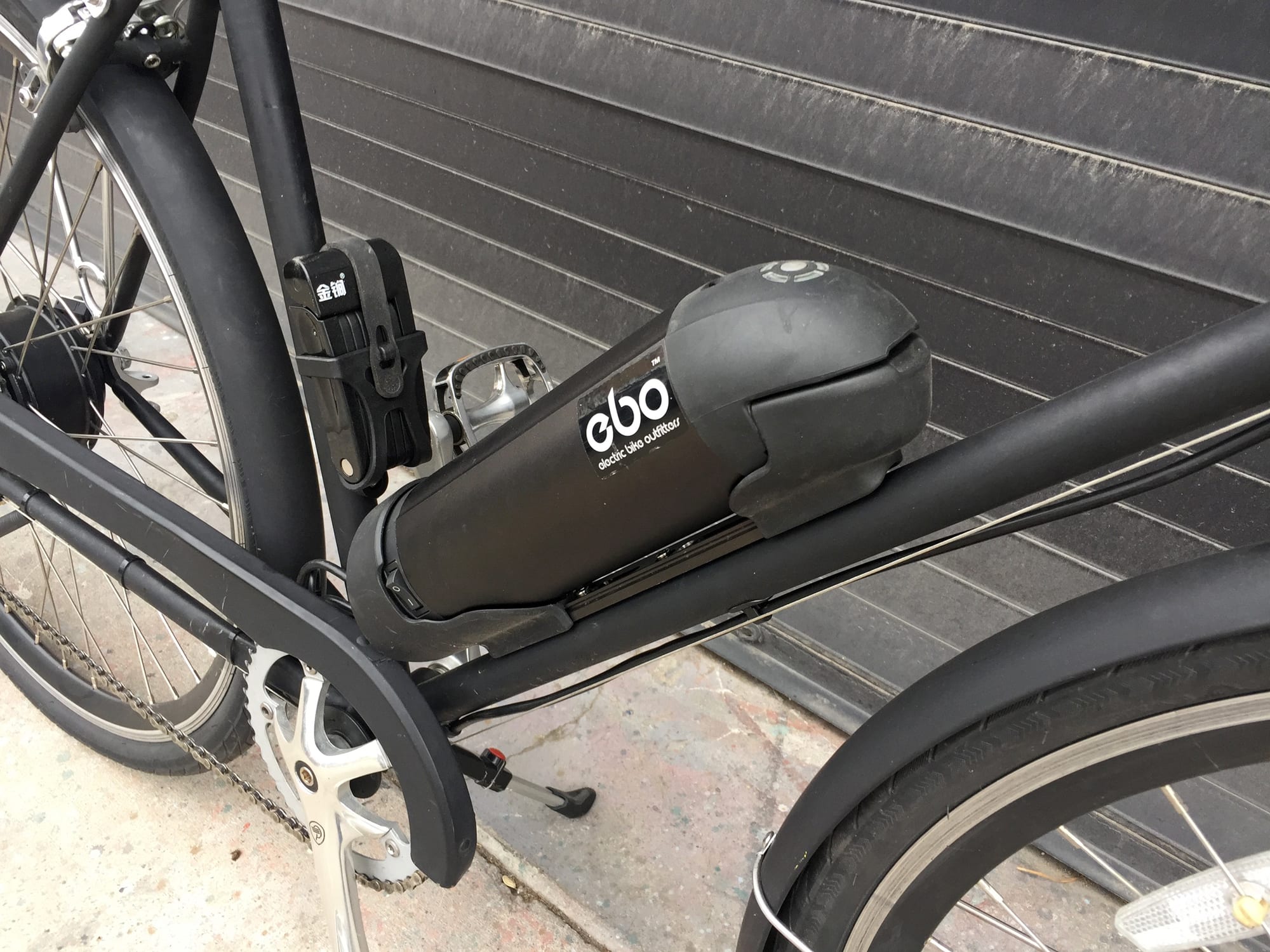
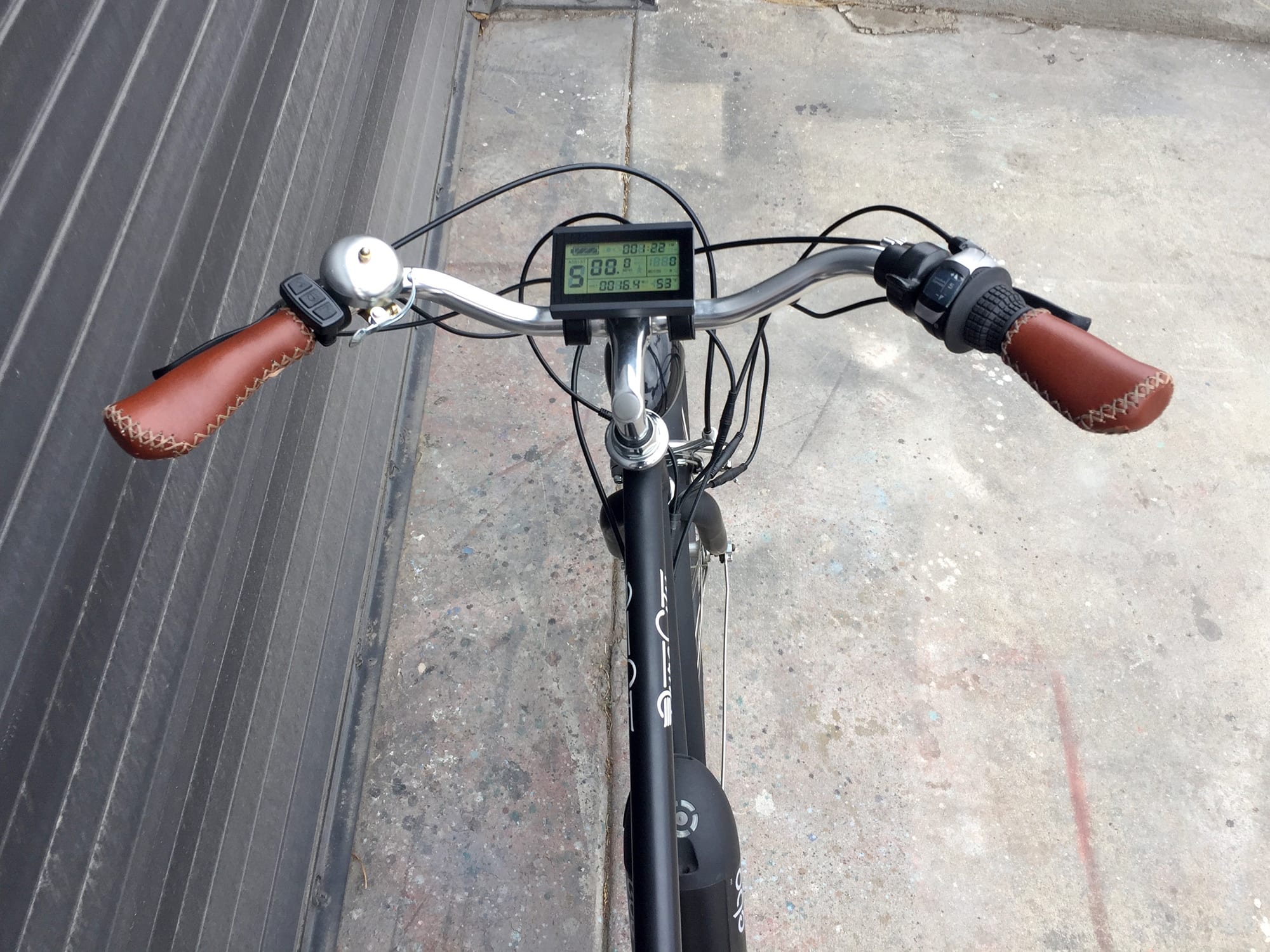
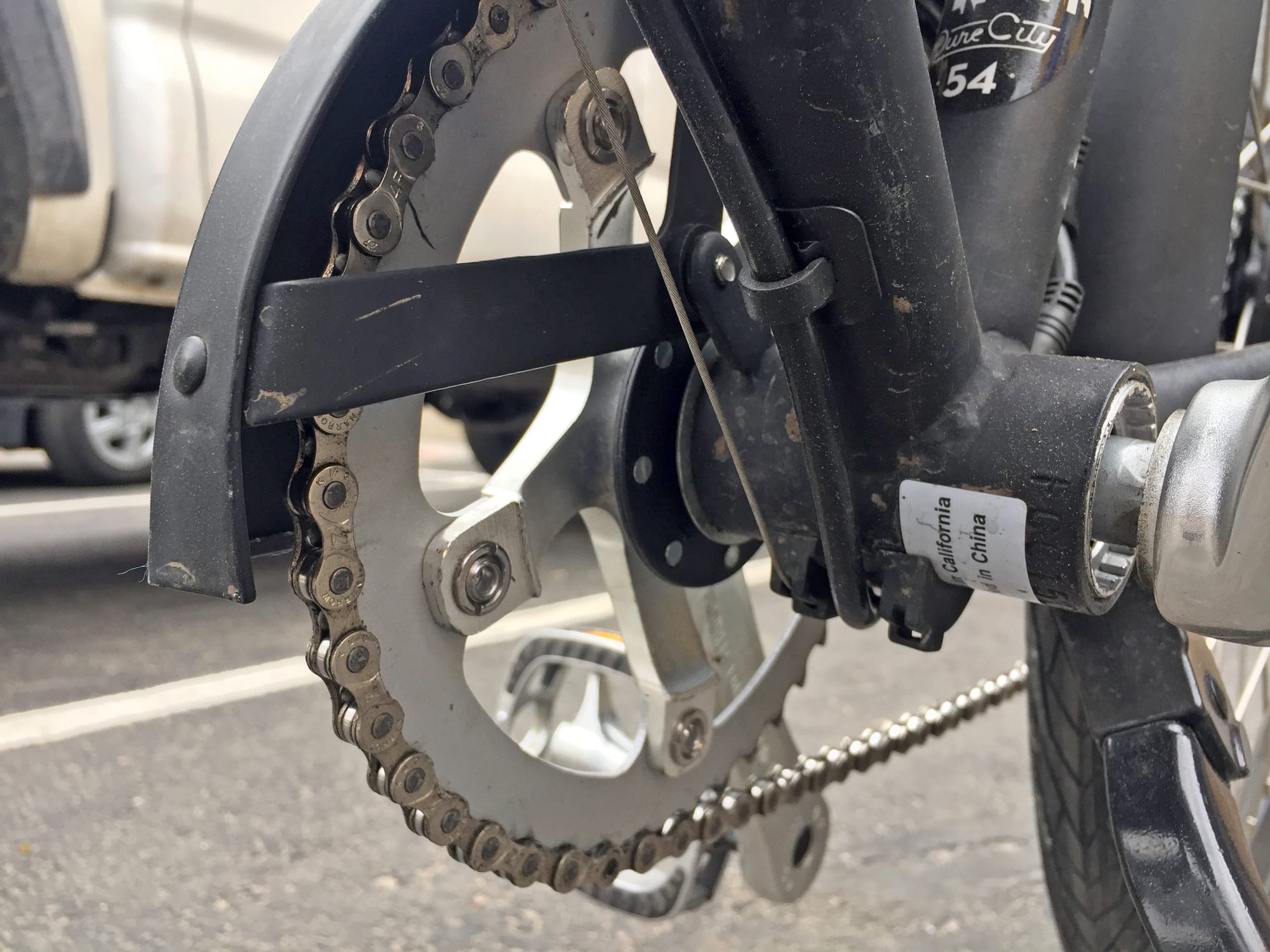
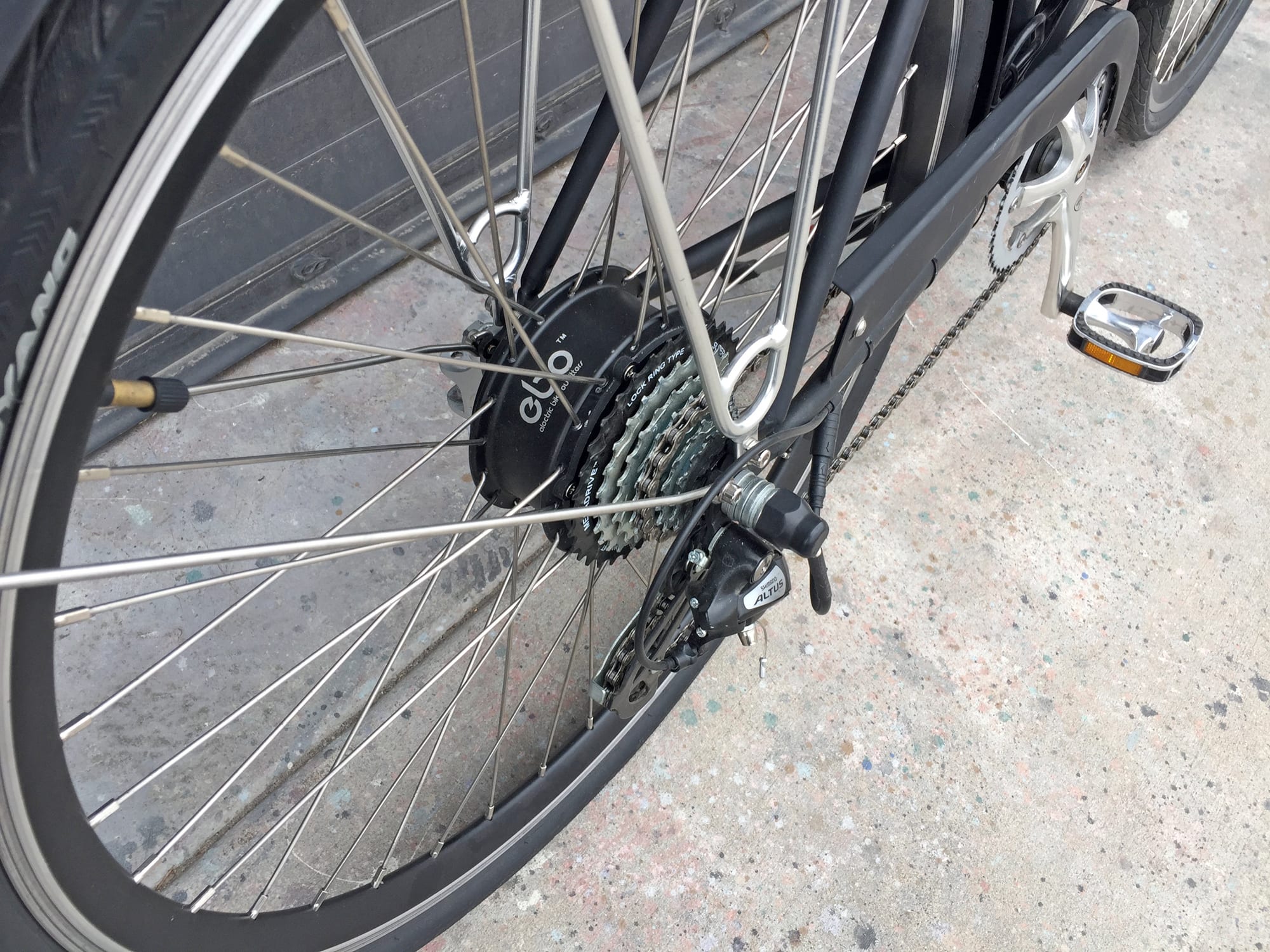


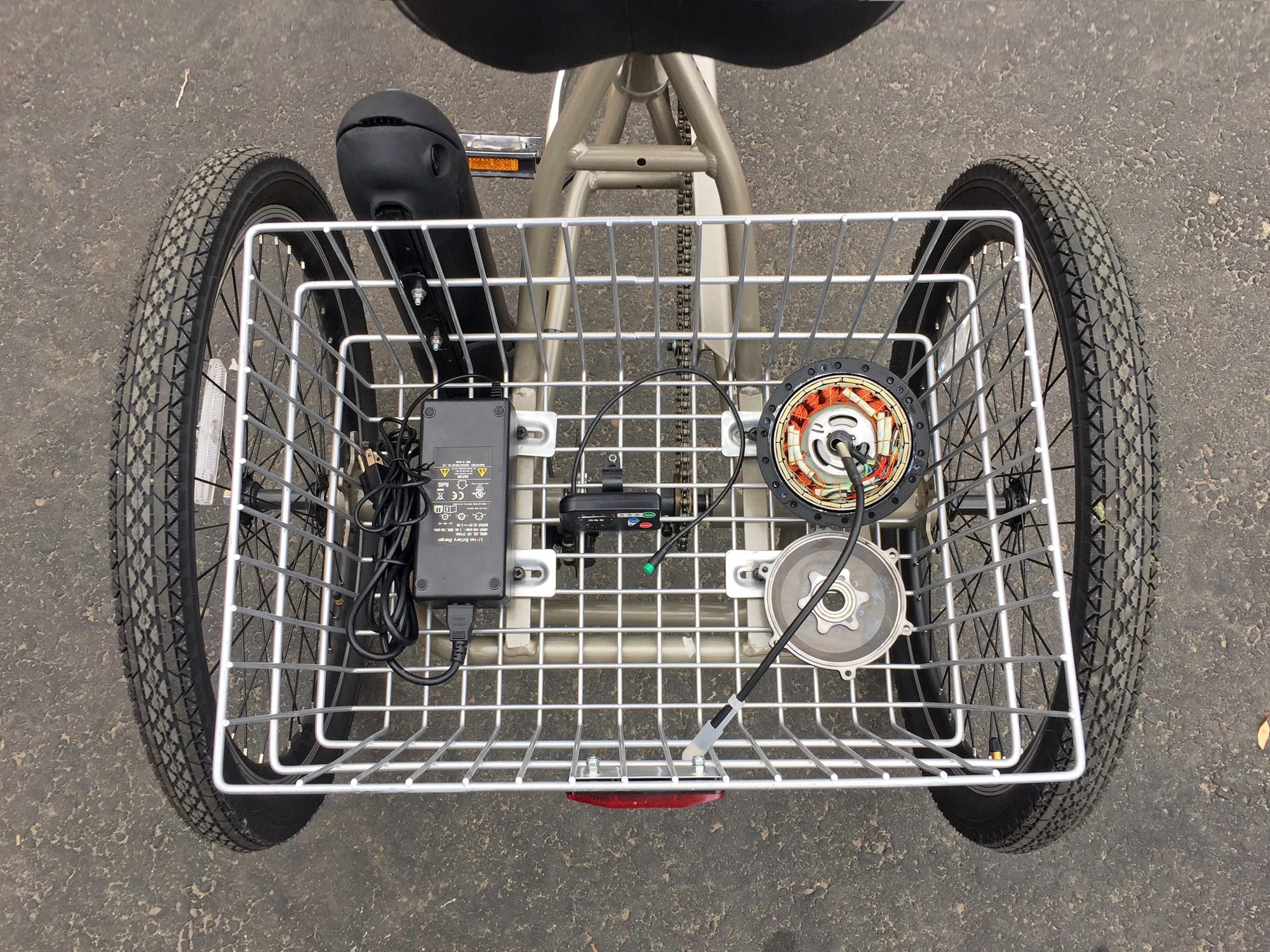
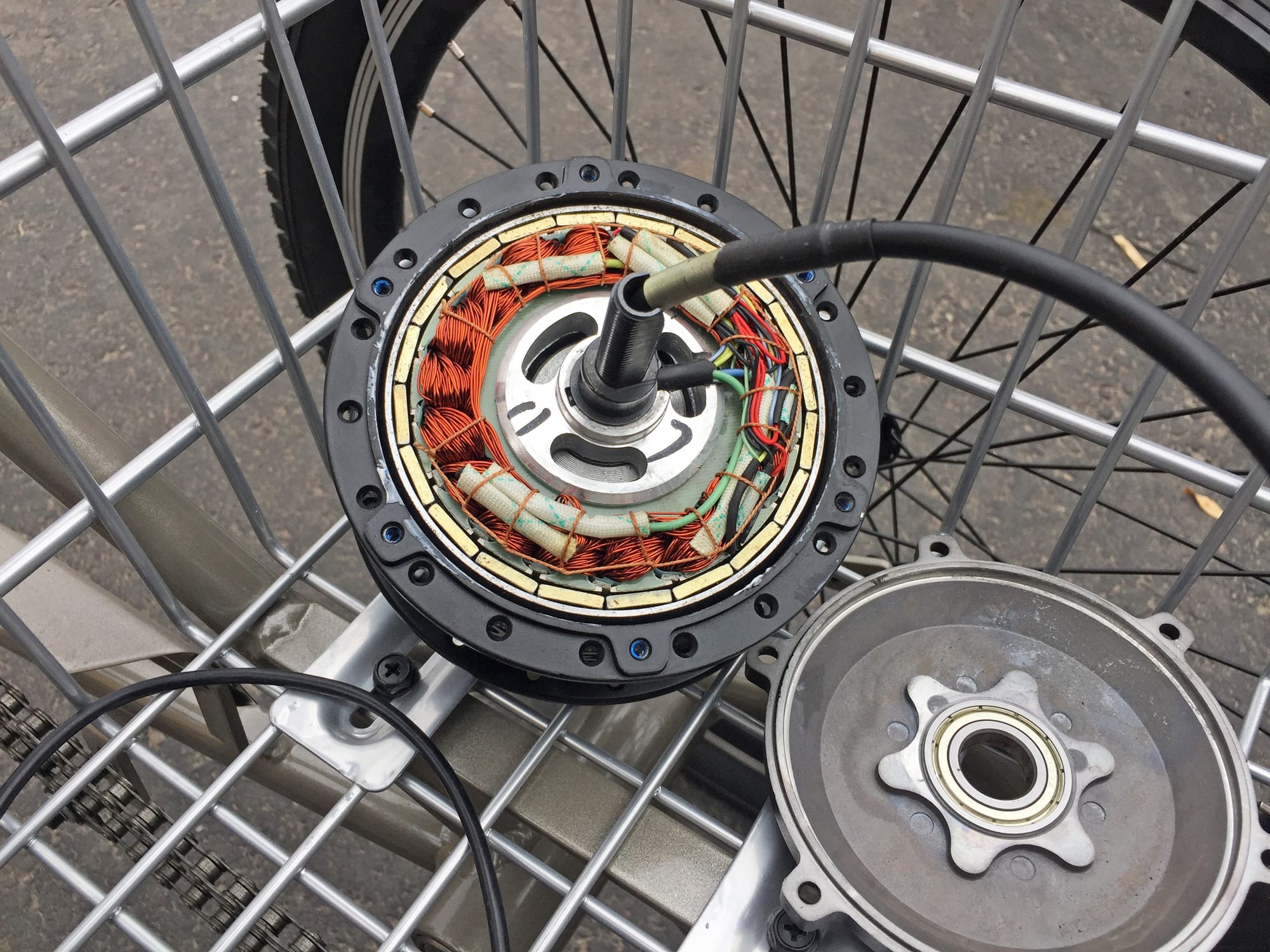
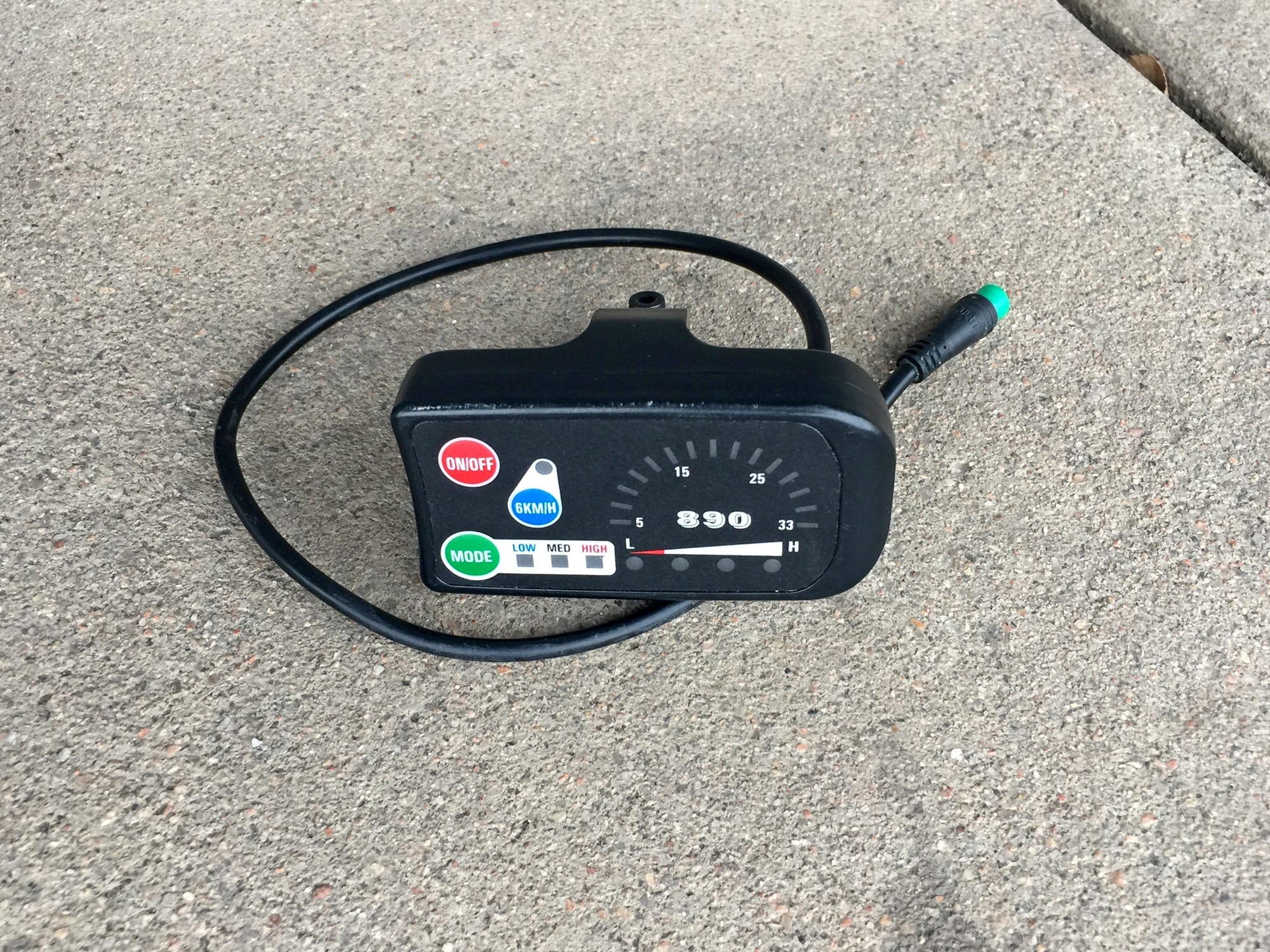

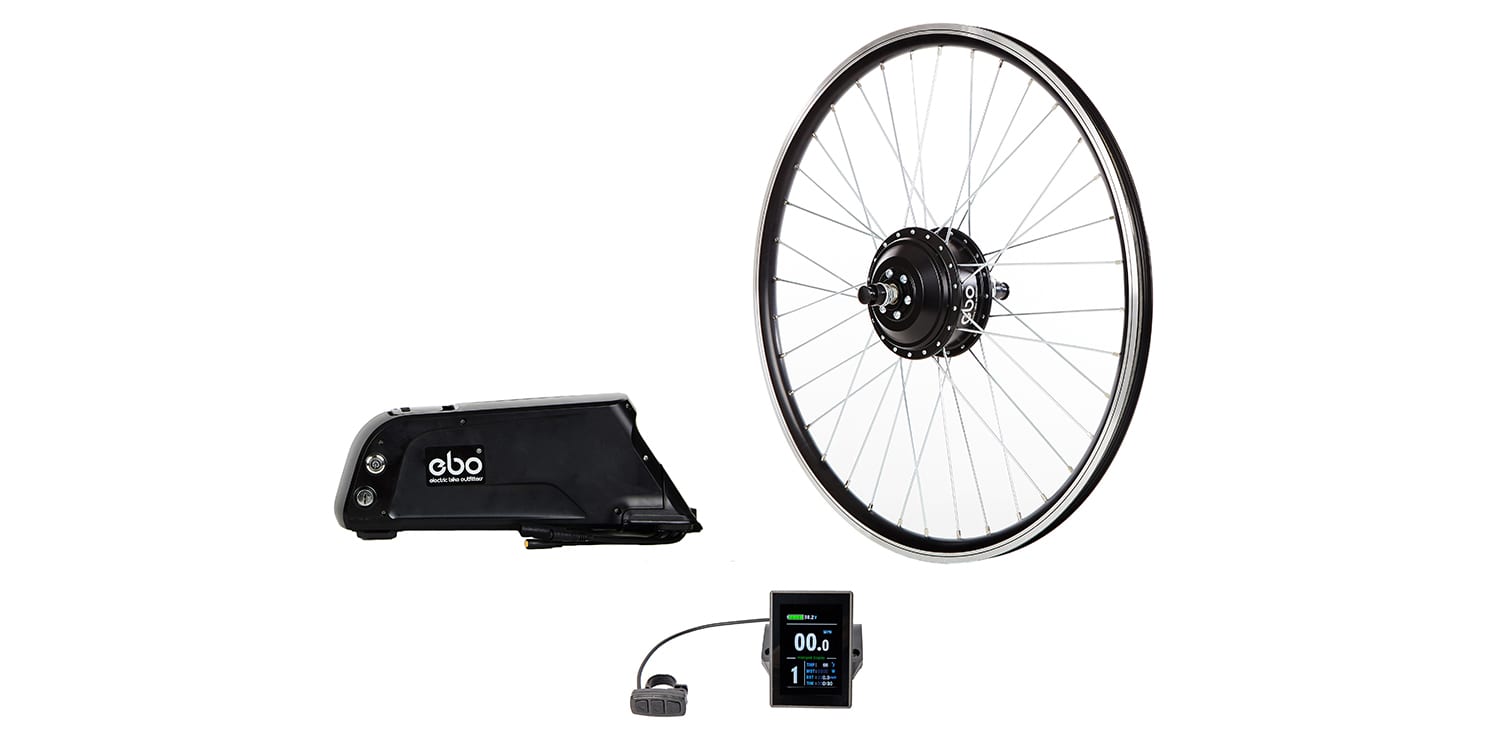
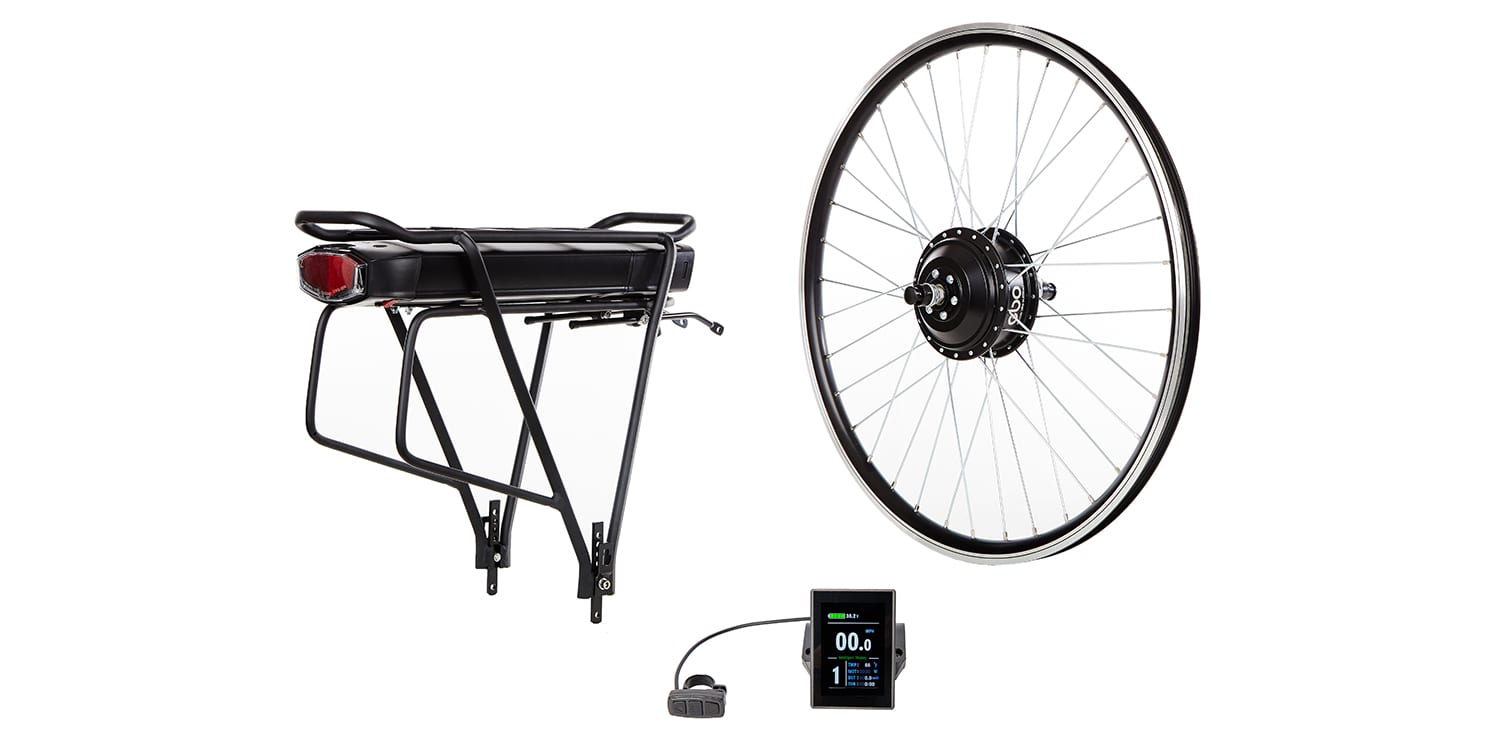


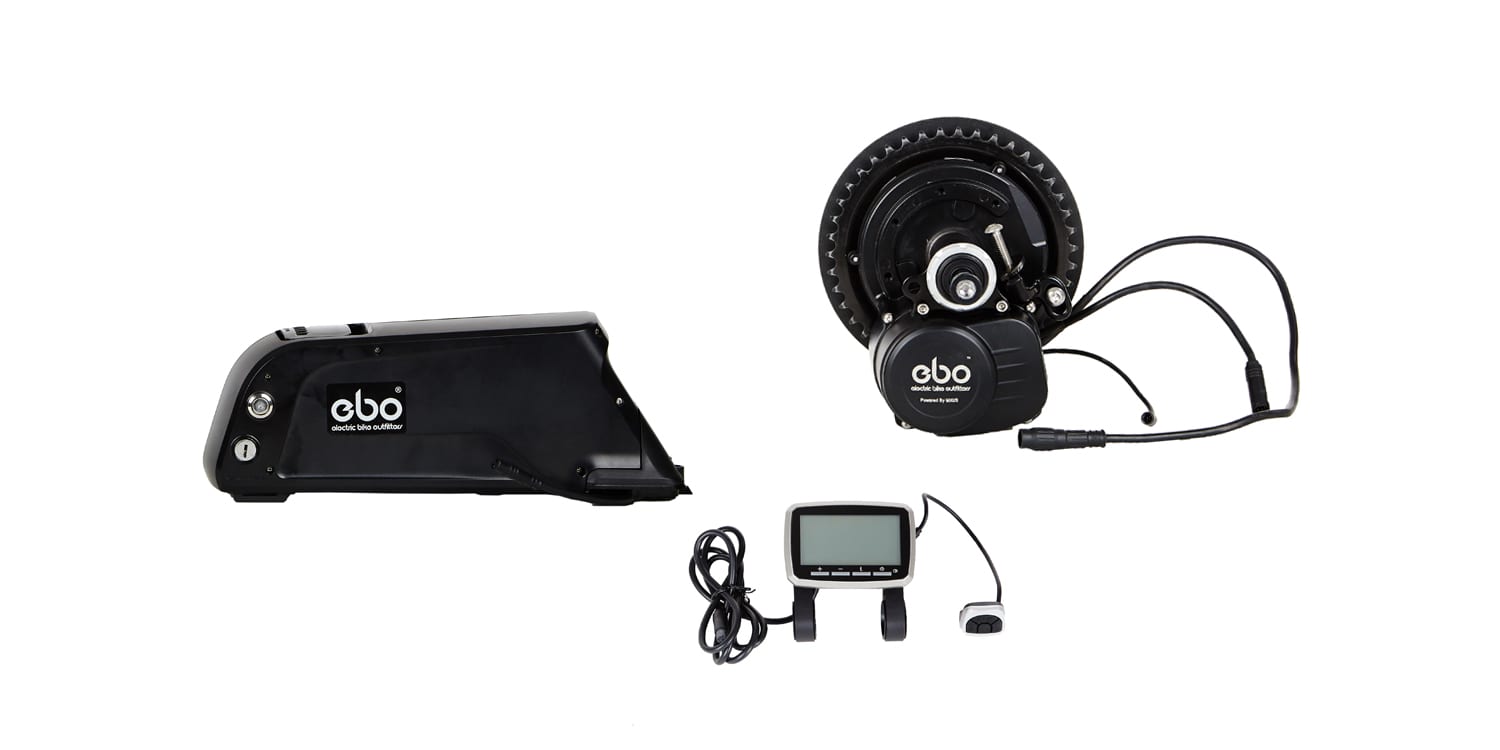
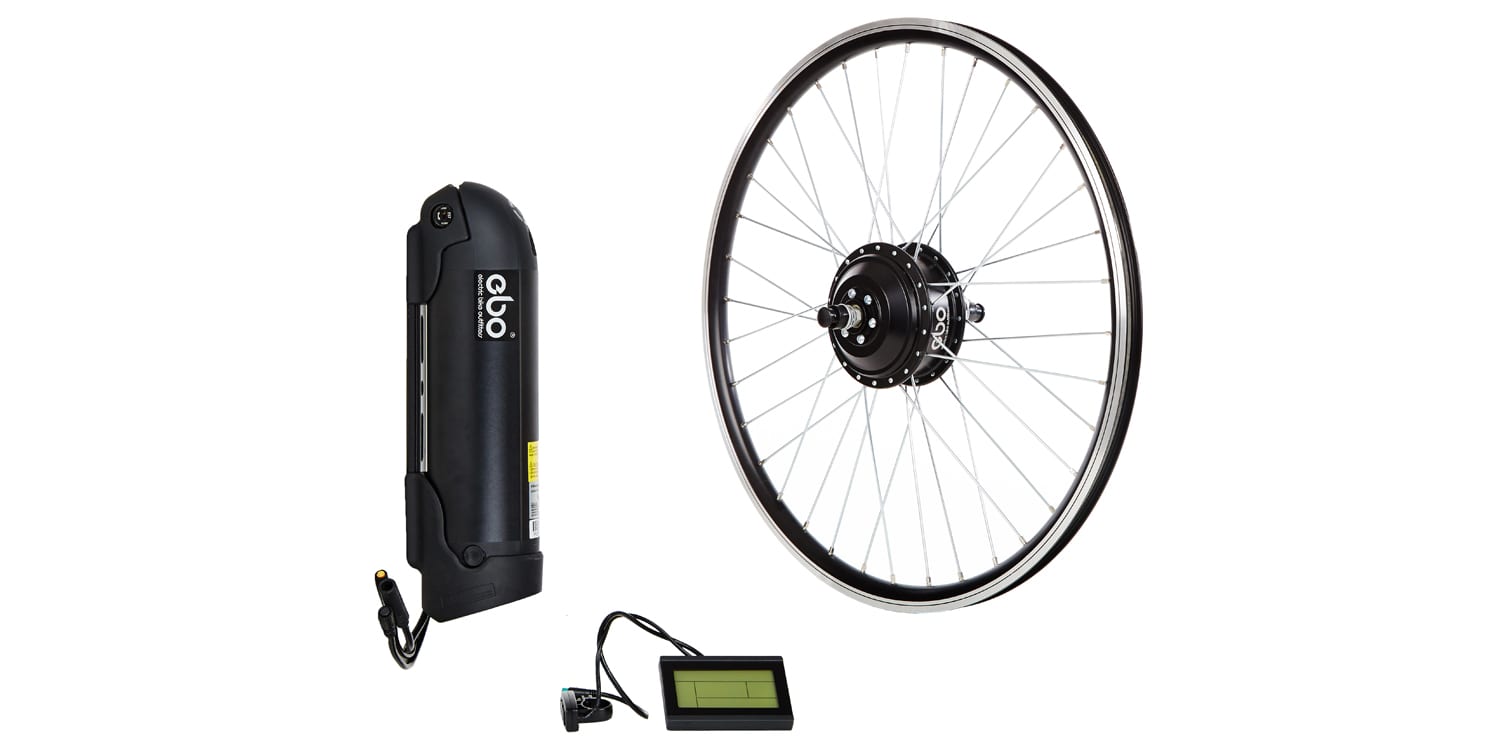
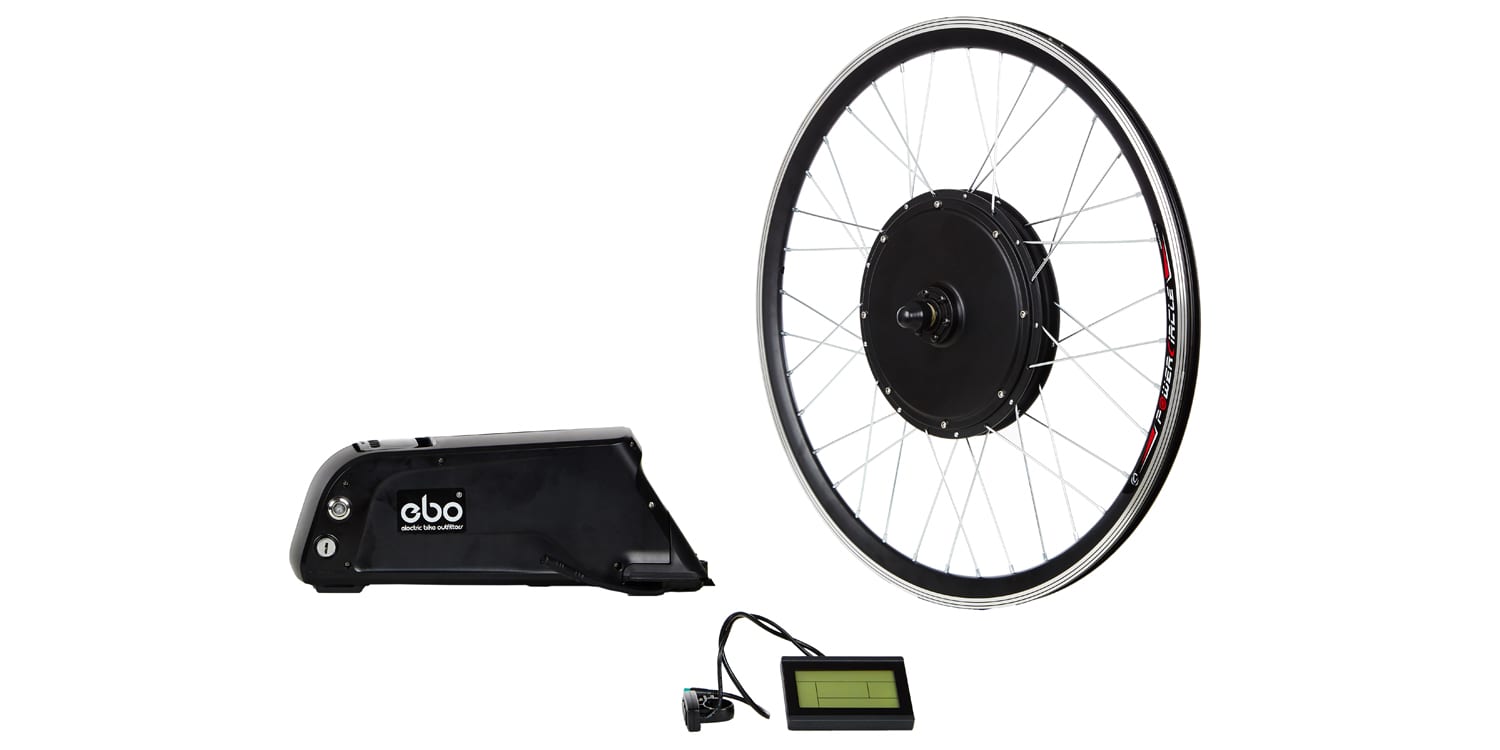
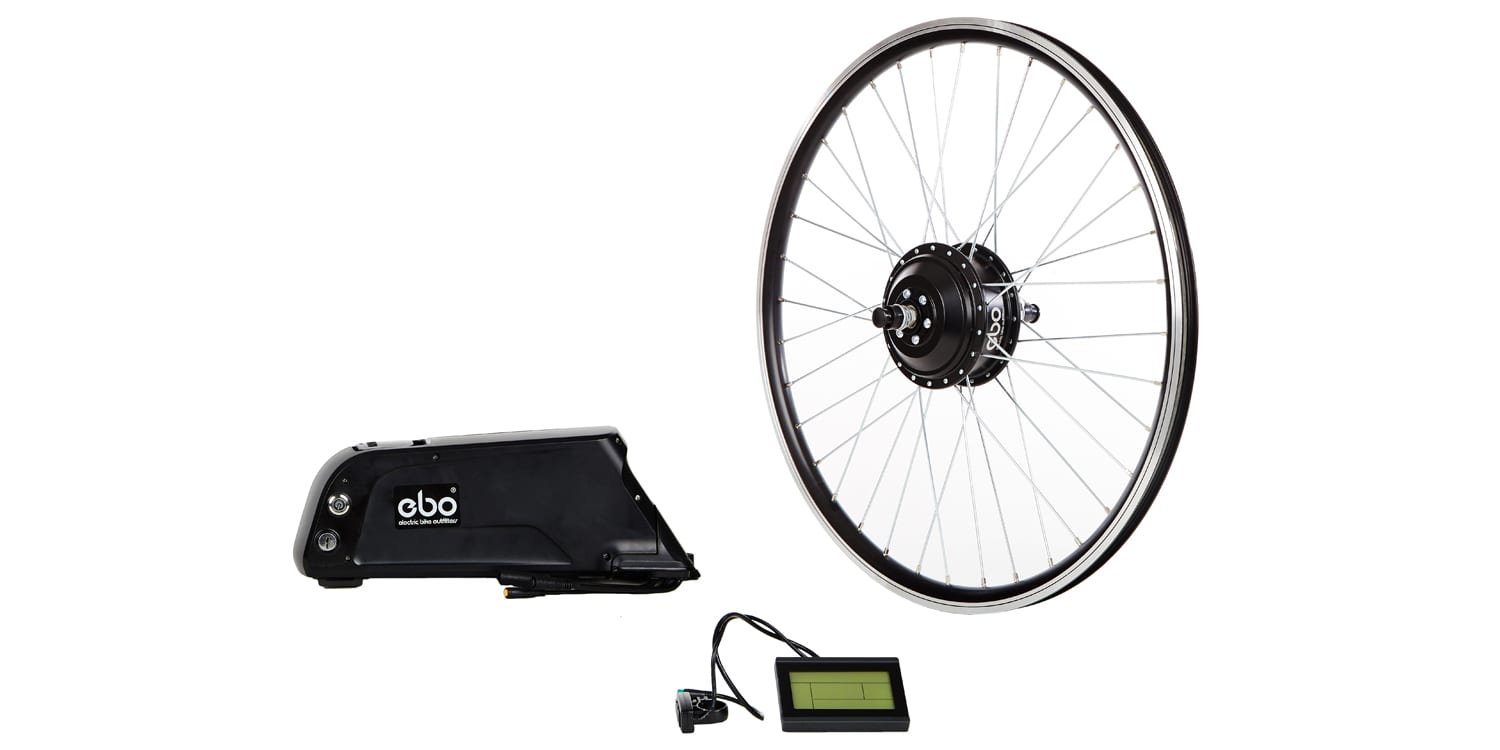
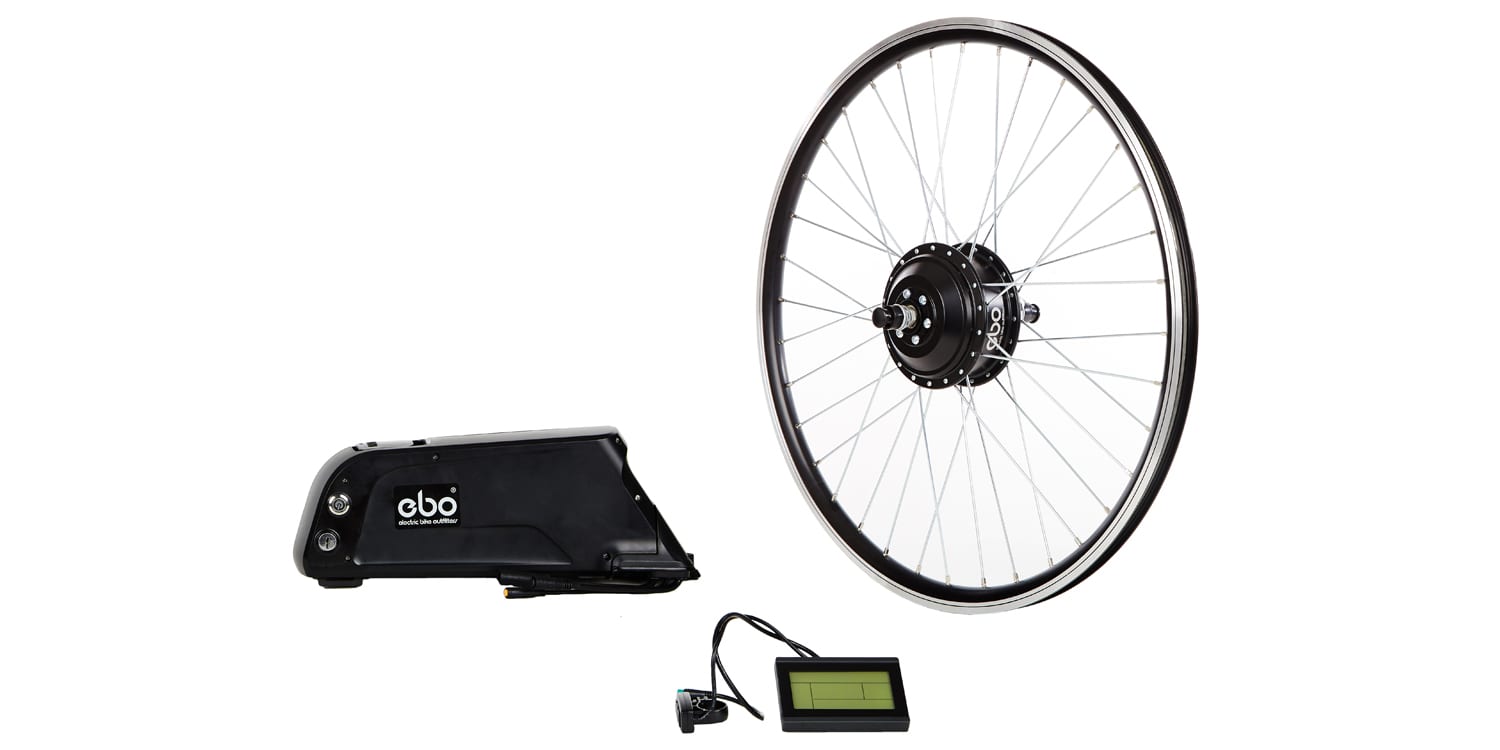
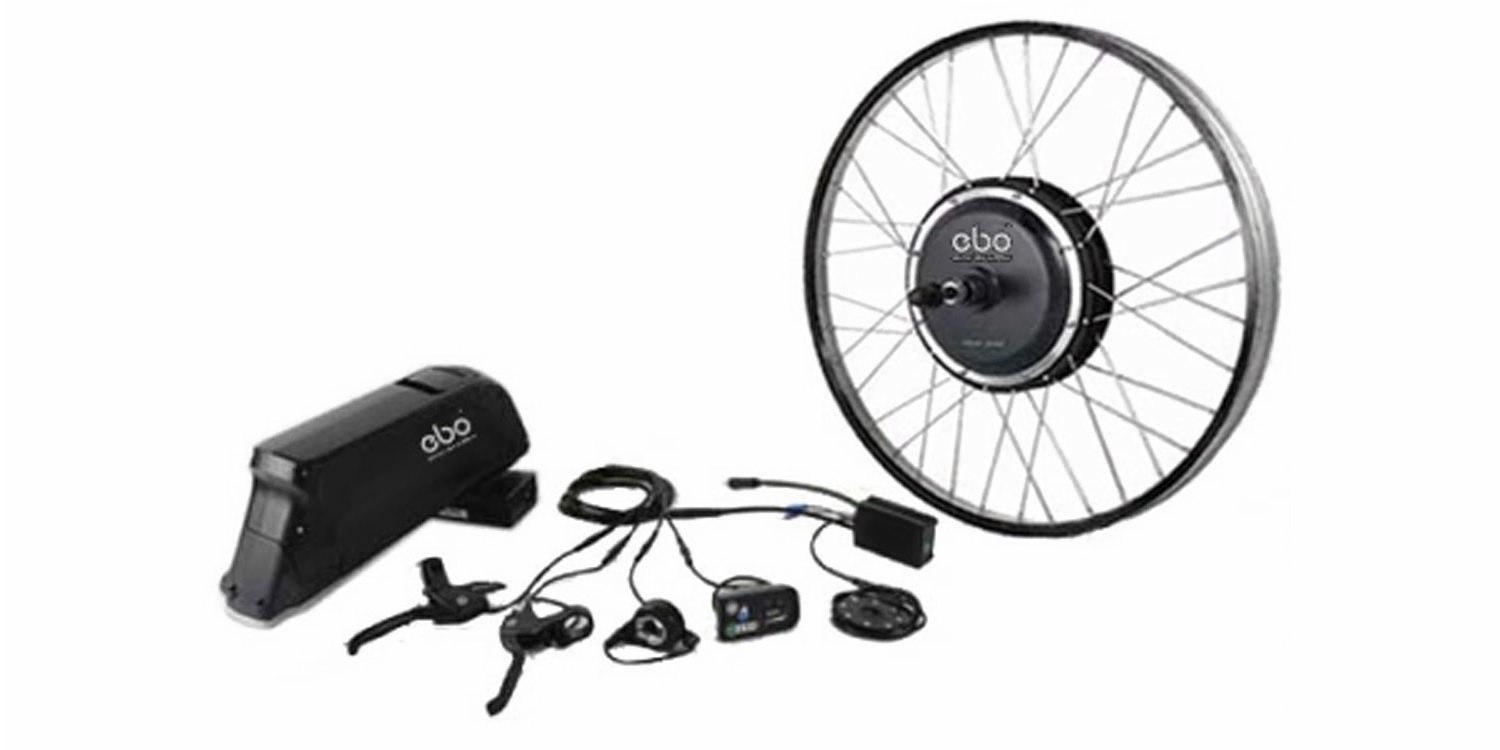
Augsburg says
Thanks for the review. We have a unique situtation and it sounds like this kit might work. We have a very expenisive and high quality European city bike (Retrovelo Alfons), with an eliptical bottom bracket (allows use of the IGH with vertical rear drop outs), disk brakes (BB7’s) and a Shimano Alfine 11-speed IGH. Therefore, to add an e-assist kit, a front hub is the primary option. We are thinking a mid-drive would be problematic with an eliptical bottom bracket, and we’d like to not lose the Alfine IGH.
As I read the review, the front hub version of this kit could be used. It sounds like we can attach a rotor to the motorized hub (6-bolt, I assume), and the assembly can then be slipped right into our front fork. (We’d need to verify the spacing.) Of course, all the other components from the kit would be attached.
Court says
Hi Augsburg! It sounds like you’re on the right track… Faraday also uses an elliptical bottom bracket (they call it an eccentric bottom bracket) to tighten the belt drive on some of their models. The front hub motor works well for them and it sounds like it could be a good fit for you too! I’d love to hear how things end up and definitely recommend reaching out to Jason with any questions beforehand, he appears to be easy to reach and was very friendly during my visit and reviews :)